
Kozani is a city in northern Greece, capital of Kozani regional unit and of Western Macedonia. It is located in the western part of Macedonia, in the northern part of the Aliakmonas river valley. The city lies 710 metres above sea level, 15 kilometres northwest of the artificial lake Polyfytos, 120 km south-west of Thessaloniki, between the mountains Pieria, Vermio, Vourinos and Askio. The population of the Kozani municipality is over 70,000 people. The climate of the area is continental with cold and dry winters, and hot summers.

Servia is one of the main towns in the Kozani regional unit, West Macedonia, Greece. It is one of the most historical places in the region, with a 6th-century Byzantine castle and the Kamvounia mountain dominating the landscape. There are also a number of 10th century Byzantine cave hermitages and small churches located nearby, which add to the Byzantine atmosphere of the area.

Western Macedonia is one of the thirteen administrative regions of Greece, consisting of the western part of Macedonia. Located in north-western Greece, it is divided into the regional units of Florina, Grevena, Kastoria, and Kozani. With a population of approximately 255,000 people, as of 2021, the region had one of the highest unemployment rates in the European Union.

A mansion is a large dwelling house. The word itself derives through Old French from the Latin word mansio "dwelling", an abstract noun derived from the verb manere "to dwell". The English word manse originally defined a property large enough for the parish priest to maintain himself, but a mansion is no longer self-sustaining in this way. Manor comes from the same root—territorial holdings granted to a lord who would "remain" there.

West Wycombe Park is a country house built between 1740 and 1800 near the village of West Wycombe in Buckinghamshire, England. It was conceived as a pleasure palace for the 18th-century libertine and dilettante Sir Francis Dashwood, 2nd Baronet. The house is a long rectangle with four façades that are columned and pedimented, three theatrically so. The house encapsulates the entire progression of British 18th-century architecture from early idiosyncratic Palladian to the Neoclassical, although anomalies in its design make it architecturally unique. The mansion is set within an 18th-century landscaped park containing many small temples and follies, which act as satellites to the greater temple, the house.
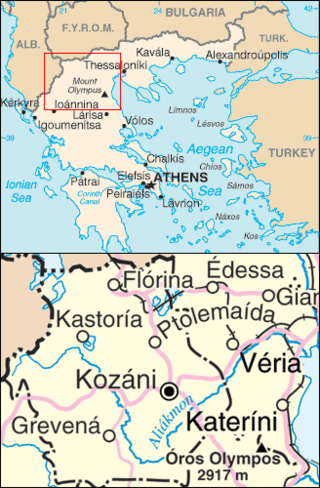
The Haliacmon is the longest river flowing entirely in Greece, with a total length of 297 km (185 mi). In Greece there are three rivers longer than Haliakmon, Maritsa, Struma (Strymónas), both coming from Bulgaria, and Vardar coming from North Macedonia, but the length of each one of them in Greek territory is less than that of Haliakmon, which flows entirely in Greece. Haliacmon is the traditional English name for the river, but many sources cite the formerly official Katharevousa version of the name, Aliákmon. Today, the only official variant is the demotic Aliákmonas. It flows through the Greek regions of West Macedonia and Central Macedonia. Its drainage basin is 8,813 km2 (3,403 sq mi).
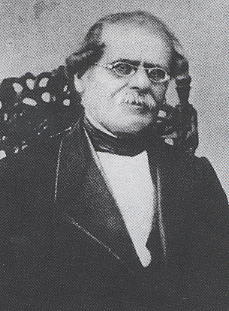
Stamatios or Stamatis Kleanthis was a Greek architect.
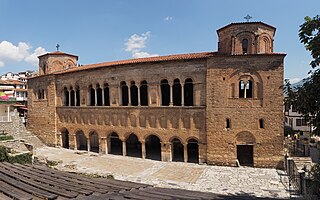
The Church of Saint Sophia is a church in Ohrid, North Macedonia. The church is one of the most important monuments of North Macedonia, housing architecture and art from the Middle Ages.
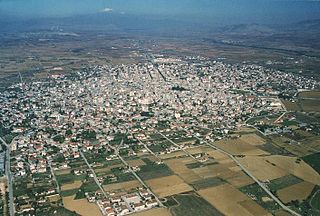
Ptolemaida is a town and a former municipality in Kozani regional unit, Western Macedonia, Greece. Since the 2011 local government reform it is part of the municipality Eordaia, of which it is the seat and a municipal unit. It is known for its coal (lignite) mines and its power stations.

Ali Qapu Palace or the Grand Ali Qapu is an imperial palace in Isfahan, Iran. It is located on the western side of the Naqsh-e Jahan Square, opposite to Sheikh Lotfollah Mosque, and had been originally designed as a vast portal entrance to the grand palace which stretched from the Naqsh-e Jahan Square to the Chahar Baq Boulevard. The palace served as the official residence of Persian Emperors of the Safavid dynasty. UNESCO inscribed the Palace and the Square as a World Heritage Site due to its cultural and historical importance. The palace is forty-eight meters high and there are six floors, each accessible by a difficult spiral staircase. In the sixth floor, Music Hall, deep circular niches are found in the walls, having not only aesthetic value, but also acoustic. Ali Qapu is regarded as the best example of Safavid architecture and a symbol of Iran's Islamic heritage.

Kozani is one of the regional units of Greece. It is part of the region of Western Macedonia, in the geographic region of Macedonia. Its capital is the city of Kozani.

Marble House, a Gilded Age mansion located at 596 Bellevue Avenue in Newport, Rhode Island, was built from 1888 to 1892 as a summer cottage for Alva and William Kissam Vanderbilt and was designed by Richard Morris Hunt in the Beaux Arts style. It was unparalleled in opulence for an American house when it was completed in 1892. Its temple-front portico resembles that of the White House.
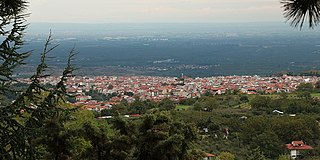
Naousa, officially The Heroic City of Naousa is a city in the Imathia regional unit of Central Macedonia, Greece with a population of 21,139 (2016). It is located at the foot of the Vermio Mountains. According to the 2011 census its population was 20,176 inhabitants. The wider municipality, after the administrative reform of the Kallikratis plan, had a population of 32,470 inhabitants. Since 1955, by royal decree, it has been designated as a heroic city for the struggle and sacrifices of the inhabitants in 1822, during the Greek War of Independence.

Aiani is a town and a former municipality in the Kozani regional unit, Macedonia, Greece. Since the 2011 local government reform it is part of the municipality Kozani, of which it is a municipal unit and historical seat of the municipality of Kozani. It is located near Haliacmon river and is 22 km south of the city of Kozani. The municipal community of Aianis is classified as an urban semi-mountainous settlement, with an area of 52,583 km² (2011). The 2011 census recorded 2,006 residents in the village and 3,429 residents in municipal unit of Aiani. The municipal unit has an area of 156.004 km2, the community 52.336 km2.

The architecture of Penang reflects the 171 years of British presence on the island, coalescing with local, Chinese, Indian, Islamic and other elements to create a unique and distinctive brand of architecture. Along with Malacca, Penang is an architectural gem of Malaysia and Southeast Asia. Unlike Singapore, also a Straits Settlement, where many heritage buildings had to make way for modern skyscrapers and high-rise apartments due to rapid development and acute land scarcity, Penang's architectural heritage has enjoyed a better fate. Penang has one of the largest collections of pre-war buildings in Southeast Asia. This is for the most part due to the Rent Control Act which froze house rental prices for decades, making redevelopment unprofitable. With the repeal of this act in 2000 however, property prices skyrocketed and development has begun to encroach upon these buildings, many of which are in a regrettable state of disrepair. The government in recent years has allocated more funding to finance the restoration of a number of derelict heritage buildings, most notably Suffolk House, City Hall and historic buildings in the old commercial district.

Nymfaio and in Ancient Greece: Νυμφαῖον or Νύμφαιον, is a village and a former community in Florina regional unit, Western Macedonia, Greece. After the 2011 local government reform it became a member of the municipality Amyntaio. The municipal unit has an area of 28.209 km2. As of 2011 the village had a population of 132 residents. The village is protected by the Hellenic Ministry of Culture in order to preserve its architectural integrity.

Churche's Mansion is a timber-framed, black-and-white Elizabethan mansion house at the eastern end of Hospital Street in Nantwich, Cheshire, England. The Grade I listed building dates from 1577, and is one of the very few to have survived the Great Fire of Nantwich in 1583.

Charlottenborg Palace is a large town mansion located on the corner of Kongens Nytorv and Nyhavn in Copenhagen, Denmark. Originally built as a residence for Ulrik Frederik Gyldenløve, it has served as the base of the Royal Danish Academy of Fine Arts since its foundation in 1754. Today it also houses Kunsthal Charlottenborg, an institution for contemporary art, and Danmarks Kunstbibliotek, the Royal Art Library.

The William K. Vanderbilt House, also known as the Petit Chateau, was a Châteauesque mansion at 660 Fifth Avenue in Midtown Manhattan, New York City, on the northwest corner of Fifth Avenue and 52nd Street. It was across the street from the Triple Palace of William Henry Vanderbilt, which occupied the entire block between 51st and 52nd Streets on the west side of Fifth Avenue.

The Museum of the Macedonian Struggle near Chromio, Kozani regional unit, Greece is an open-air museum created and landscaped over an area of 7 hectares presenting the struggles of the Greeks in Macedonia until it was united to Greece in 1912–13.























